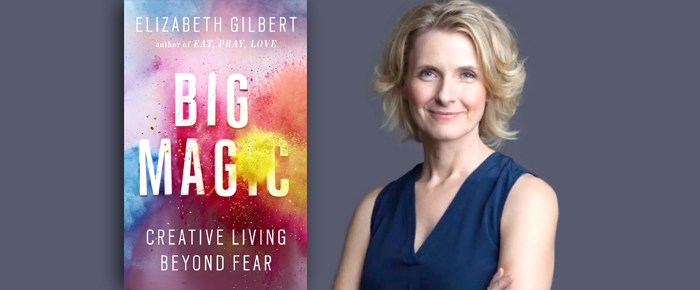
By Heidi Simmons
—–
“Big Magic”
by Elizabeth Gilbert
Non Fiction
——
Perhaps the one thing that truly sets human beings apart from animals is creativity. I’m often amazed at people’s artistic endeavors and how that art can be so meaningful, beautiful and inspirational. In Big Magic: Creative Living Beyond Fear (Riverhead Press, 208 pages), Elizabeth Gilbert explores the mystery of the creative process and encourages everyone to find their creative space to do their thing.
In 2007, Eat Pray Love was published. It was Gilbert’s fourth book. If you are not familiar with the title you are a man or live under a rock. At the time of publication, Gilbert did not give up her day job. After all, even though she already had three other books in stores and she never anticipated the new book would do well. Certainly not be enough to support her.
Today, Eat Pray Love has sold over 10 million copies, has been translated into 30 languages and was made into a movie starring Julia Roberts! With that success, Gilbert could retire. But she hasn’t because there is no way she ever could. She must write. She must stay creative.
As nice as that sounds, and even with huge financial success, being creative is not so easy.
Gilbert begins Big Magic asking: What is creativity? The answer: The relationship between a human being and the mysteries of inspiration. This book is her fight against the forces that oppose creativity. How do we find inspiration? Where do ideas come from? How do we live a creative life?
Divided into six parts, Gilbert breaks down what she considers the necessary elements to live a creative life without fear: Courage, Enchantment, Permission, Persistence, Trust and Divinity.
When she writes about creative living, she is encouraging people to live a life that is driven by curiosity. Gilbert believes the way to live a transcendent life is to value your creative time and find your own joy no matter what your day job is. She acknowledges that the path to creative living requires courage. She includes a list of things we use to keep us from being creative. You might be surprised how many you check off. But she distinguishes the difference between bravery and fearlessness. She insists fear and creativity must peacefully coexist.
Gilbert defines ideas as if they are entities traveling the planet looking for people to accept them and give them a try. She tells an incredible story where she gave up an idea for a novel she had worked on for months. That idea mysteriously transferred to another author. Several years later, she and the author discovered they had the same idea and together figured out where and how the idea moved from Gilbert to her friend without a word. Gilbert says that ideas are driven to be made manifest. You can accept the idea or let it pass.
In the chapter “The Tiger’s Tail,” Gilbert shares the story of poet Ruth Stone whose work would come to her on “the wind” and she had to race to write it down. On one occasion, the poem moved too quickly and she had to catch it by its tail and pull it back. Stone wrote the words of that poem backwards as she took down the dictation while “holding on to the tail” of the poem.
Gilbert points out that the Romans didn’t believe that an exceptionally gifted person was a genius, but rather that an exceptionally gifted person had a genius. Gilbert appreciates this thinking because it lets your creative self off the hook. “Just because creativity is mystical doesn’t mean it shouldn’t also be demystified, especially if it means liberating artists from the confines of their own grandiosity, panic and ego.” She recommends collaborating with the forces of inspiration.
“Done is better than good,” is a phrase Gilbert’s mother taught her. She uses it in her creative work believing completion is an honorable achievement. It’s nice to want to make your work perfect, but it’s better to get it finished.
There is a chapter called “The Martyr vs. the Trickster” where Gilbert writes about the addiction to creative suffering. She does not believe in suffering and recommends the way of the Trickster. She includes a list of how the Martyr thinks and how the Trickster puts a spin on it. One example: the Martyr says: “Life is pain,” and the Trickster says: “Life is interesting.”
There are so many great things in Big Magic that help us consider how the creative process works, how to stay motivated and how to let go of fear. She does not offer a road map to find commercial success, but gives valuable information to discover personal success. And creative happiness.
This is Gilbert’s eighth book. She is certainly qualified to talk on the subject of creativity and fear. She frequently uses herself as an example, which makes the read engaging and fascinating — especially if you have read any of her other books. There are wonderful anecdotes, lessons and examples.
I appreciate Gilbert’s message and mission. She desires that everyone who ever wants to be creative, to do it without fear and with no excuses. You are a human being on this planet and the fact that you exist, gives you the right to be creative.
Big Magic will help anyone who struggles with the creative process. I’m recharged and rethinking my art. So thank you Liz Gilbert for renewing my spirit and freeing my creative soul.












































